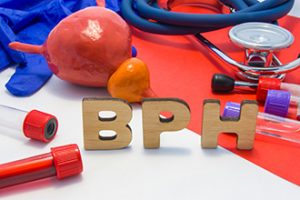As you grow older, your prostate also grows and swells. But if it becomes very large, it can lead to a condition called BPH (benign prostatic hyperplasia), which simply means your prostate has grown too large though not cancerous. Usually called an enlarged prostate, BPH is a frequent condition in men, especially those in their 50s or older. It is primarily caused by excess DHT, an extremely powerful form of testosterone which triggers aggressive multiplication of prostate cells. Recent studies also indicate that excessive estrogen in the body plays a role in the overgrowth of the prostate.
How can you know that you have an enlarged prostate?
Located right next to the bladder, the prostate is a tiny, walnut-sized gland that’s vital for the normal functioning of the male reproductive system. It is wrapped around the urethra (the tube that takes urine away from the bladder) and significantly influences how the urethra transports both sperm and semen. As the prostate grows and swells, it puts a lot of pressure on the bladder and can obstruct urine flow through the urethra, resulting in various urinary issues.
If you have an enlarged prostate, you will:
- Find it difficult to urinate.
- Experience dribbling after urinating.
- Feel the need to urinate frequently, often at night.
The early warning signs of BPH include:
1. Weak or slow urination
As your prostate enlarges, it puts pressure on your urethra and bladder, interrupting urine flow, resulting in either a weak flow or a prolonged stay in the bathroom. This is a very early and most common sign of BPH, and you’ve probably heard older men joke about how long they take to urinate. So when you have an enlarged prostate, urine does not exit normally and the resulting stream is quite weak.
2. Leaking of urine
Those embarrassing wet spots on your pants may just be the warning that you have an enlarged prostate. Why? Because a swollen prostate not only makes it difficult to urinate, but also makes it harder to retain urine in your bladder, resulting in urine leakage. The enlarged prostate also puts a lot of pressure both on your urethra and on your bladder and compromises your normal ability to hold urine.
3. Straining when urinating
Normal urination requires no effort. So if you find yourself groaning and suffering every time you are in the urinal, it may indicate that your prostate is clamping hard on your urethra.
4. Waking up several times at night to urinate
An enlarged prostate also puts extra pressure on the bladder, producing a sensation that the bladder is full even when it really isn’t. Thus waking up often at night to pass urine may indicate that you have BPH.
5. High PSA during a blood test
While prostate-specific antigen is produced in small quantities in men with healthy prostate glands and plays the critical role of liquefying semen by breaking down large seminal proteins, high levels of PSA may indicate that you have an enlarged prostate or prostate cancer. Make sure that you speak with a doctor if a test shows that you have high PSA in your blood.
6. Sexual dysfunction
BPH can trigger erectile dysfunction and difficulty with ejaculation by applying extreme pressure on the urethra (which transports both urine and semen) and reducing your sexual function. So if you are finding it difficult to have an erection or ejaculation, you should see your doctor for an examination to identify the problem. It may just be an enlarged prostate.
How can a urologist help?
When you experience the warning signs, you need to see your doctor to determine if you have an enlarged prostate. If an examination establishes that you have BPH, the urologist will recommend the right treatment. The most common approaches to treating BPH include:
1. Watchful waiting (active surveillance): If during assessment it is found that your symptoms are mild and not very troublesome, the urologist may recommend that you wait for a while before you commence treatment. Your symptoms will be monitored during this period to see if they are getting worse and require intervention. Your doctor will determine how frequent you need to go for checkup. The treatment can be started later if the symptoms worsen.
2. Medications: Your urologist may recommend medicines for shrinking the prostate gland or to relax the muscles around the gland in order to reduce or relieve symptoms. Make sure to speak with your doctor about possible side effects of these medicines.
3. Surgery: If medicines fail, the urologist may suggest that you undergo surgery to help improve urine flow. Different types of surgical procedures can be used, so talk to your doctor about the right option for you and about the risks involved. After surgery, regular medical checkups are very important.
4. Other treatments: To reduce the extra prostate tissue and relieve urinary problems associated with BPH, treatments such as microwaves, lasers or radio waves may be considered.
Want to know more about the health issues associated with the prostate, their diagnosis and treatment? Or you suspect that you have a prostate problem and want to speak to a knowledgeable and experienced urologist? Get all the information and help you need today by visiting the “St Pete Urology” site.



